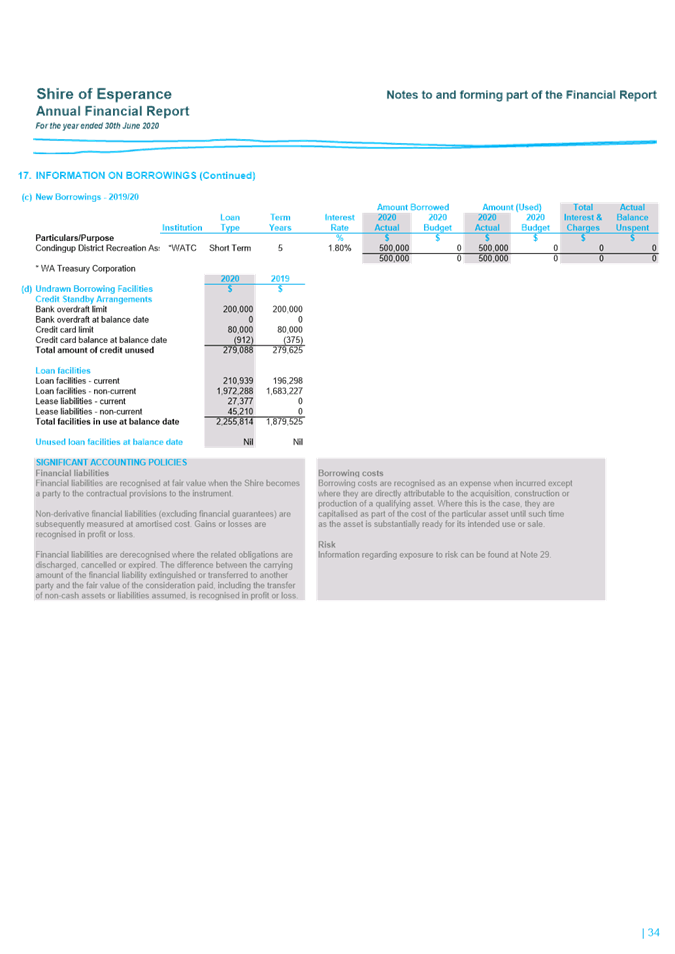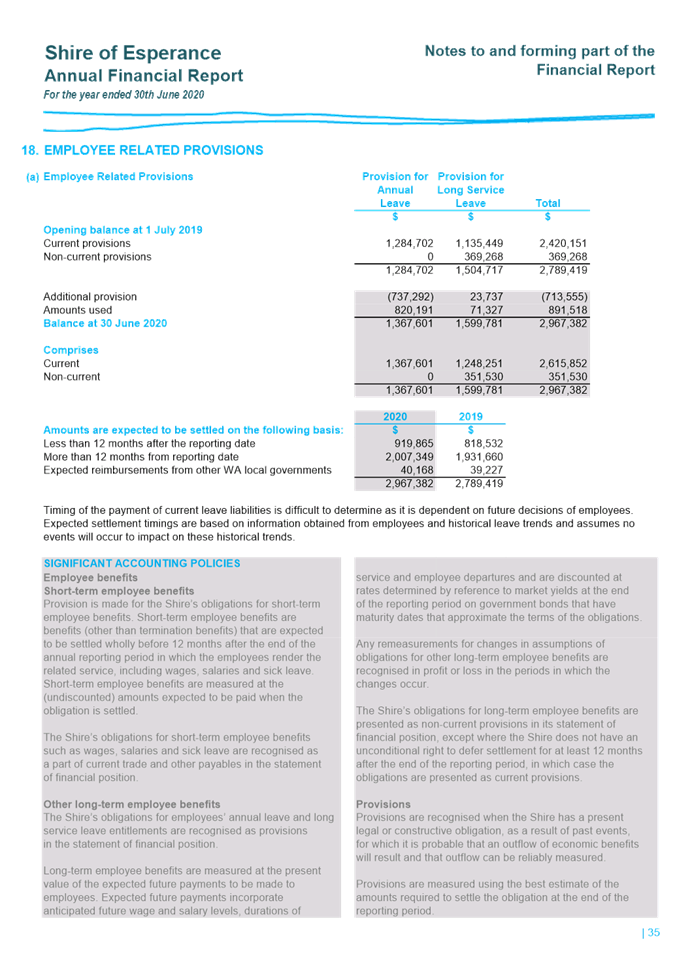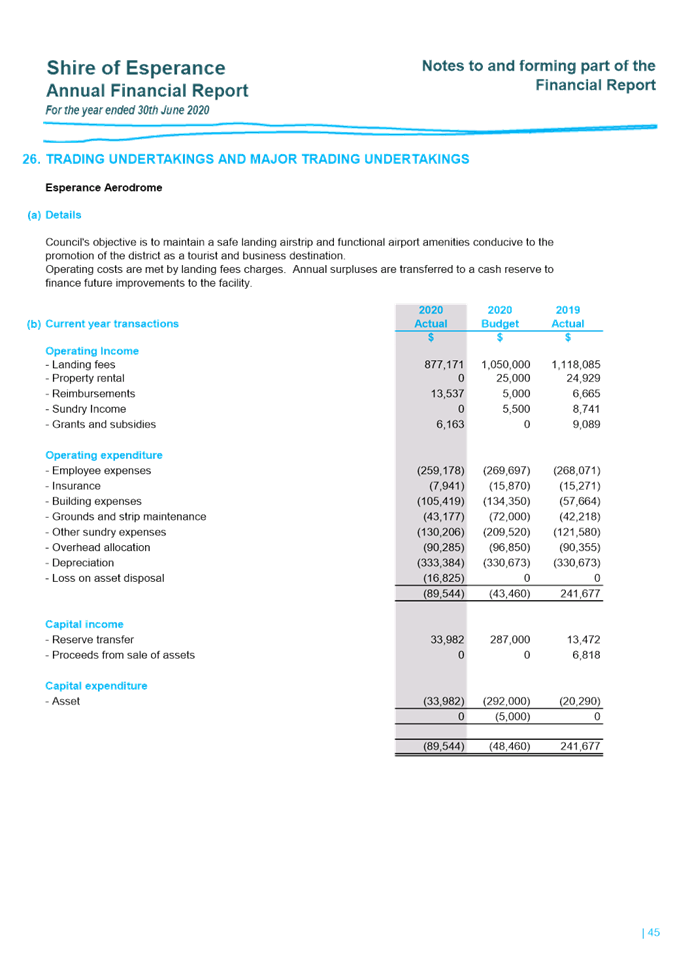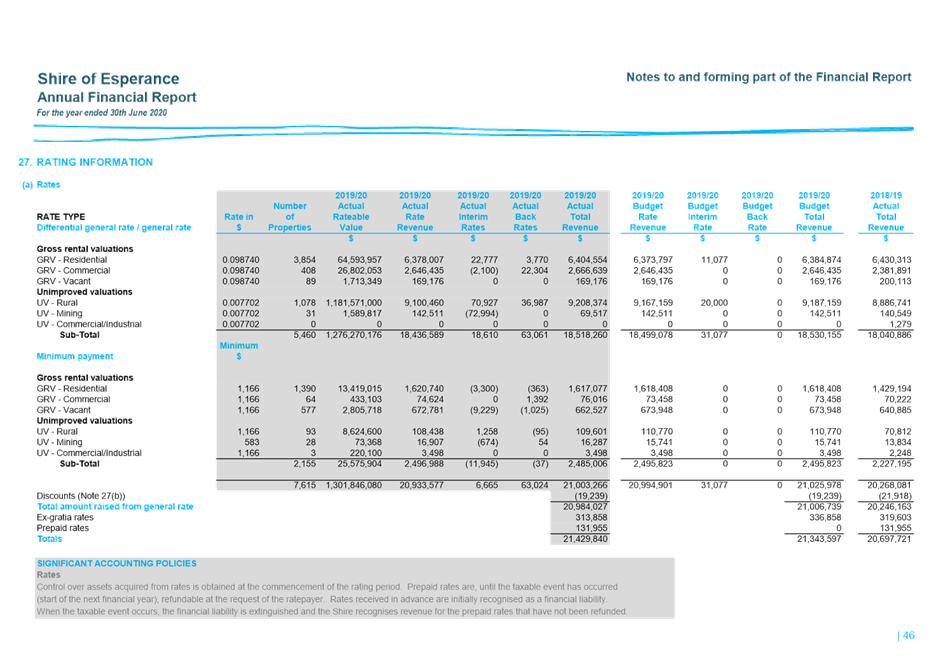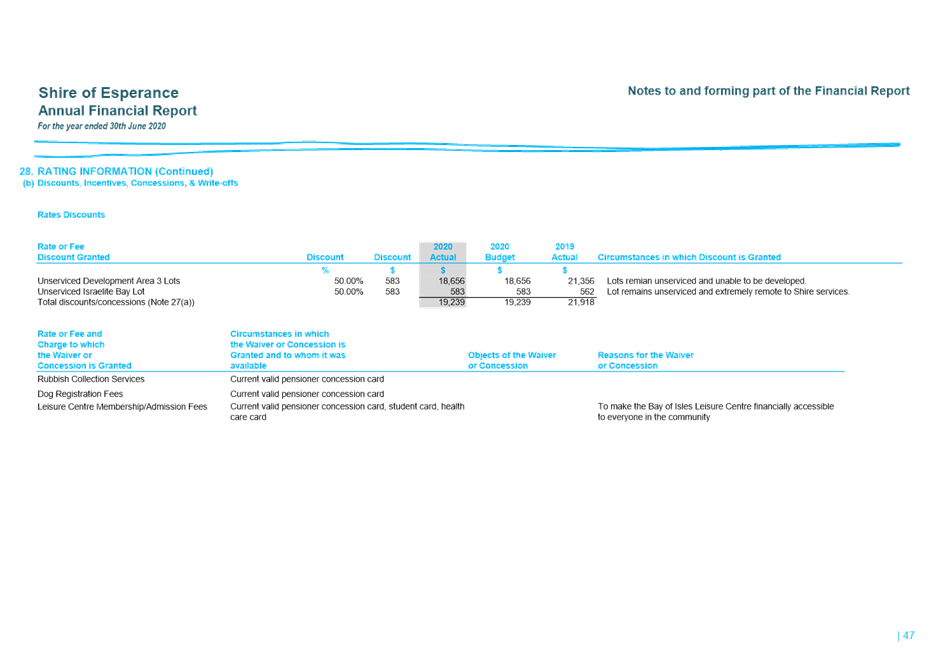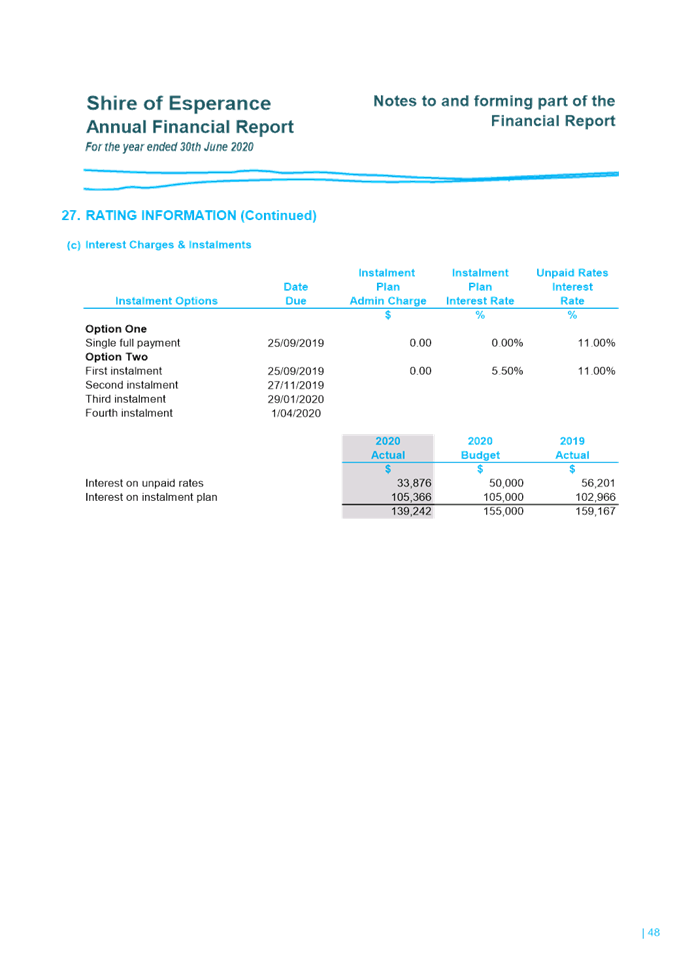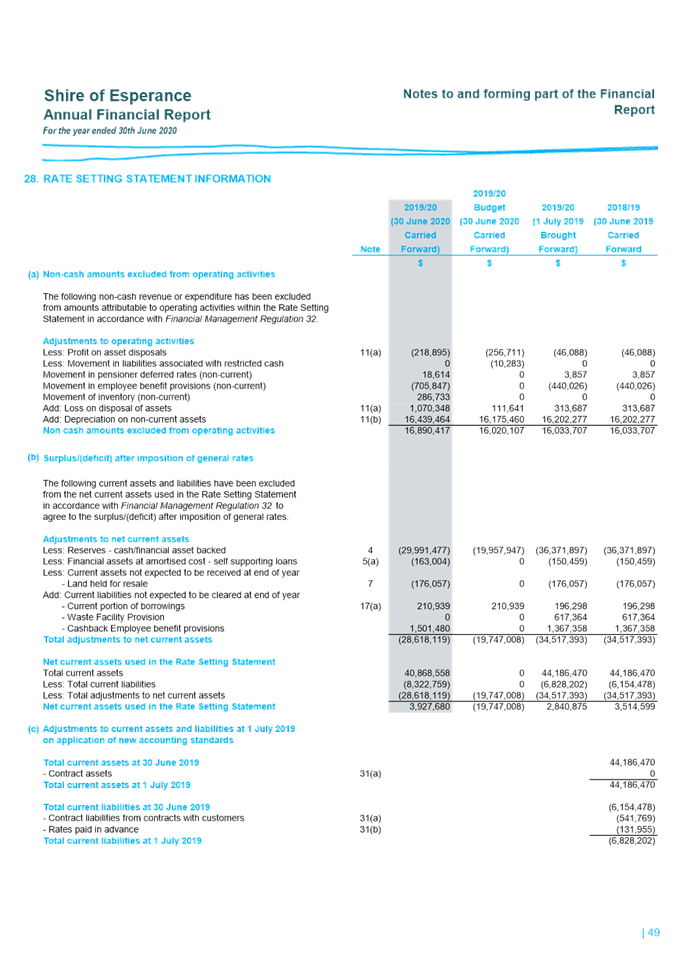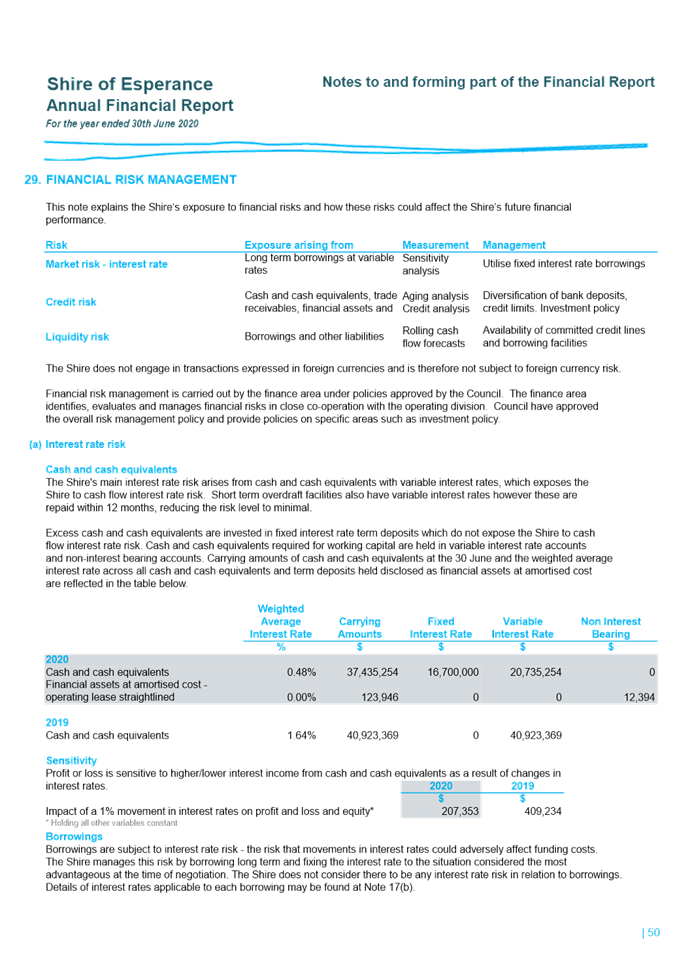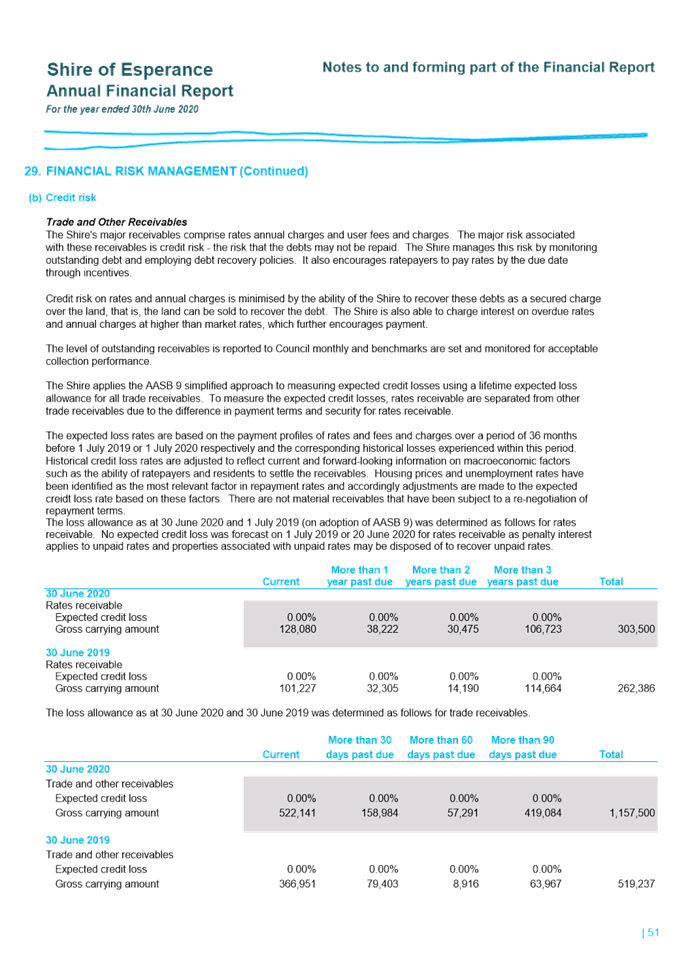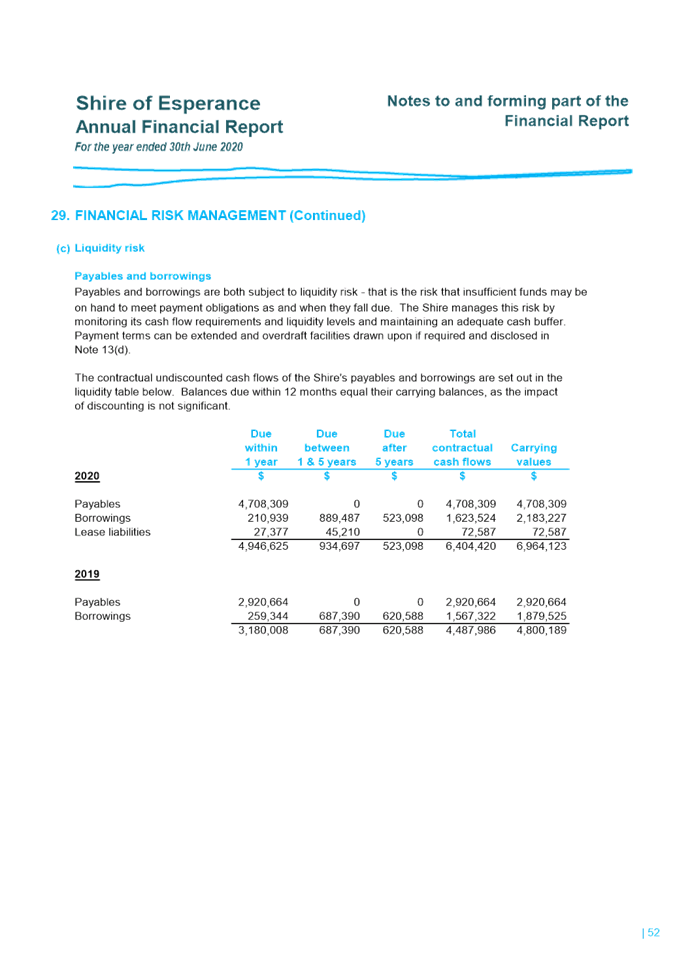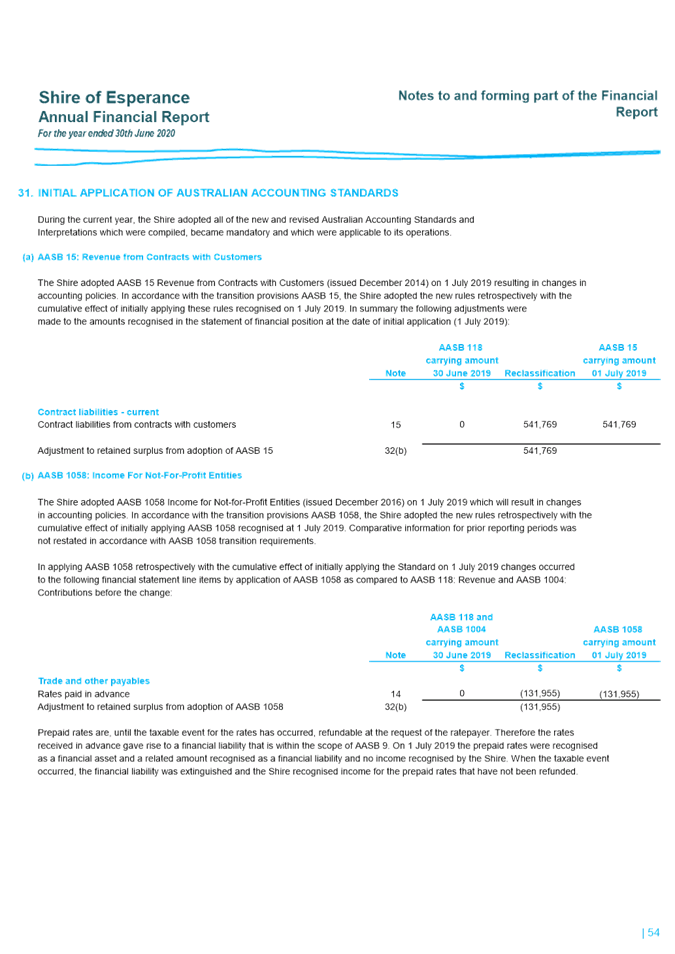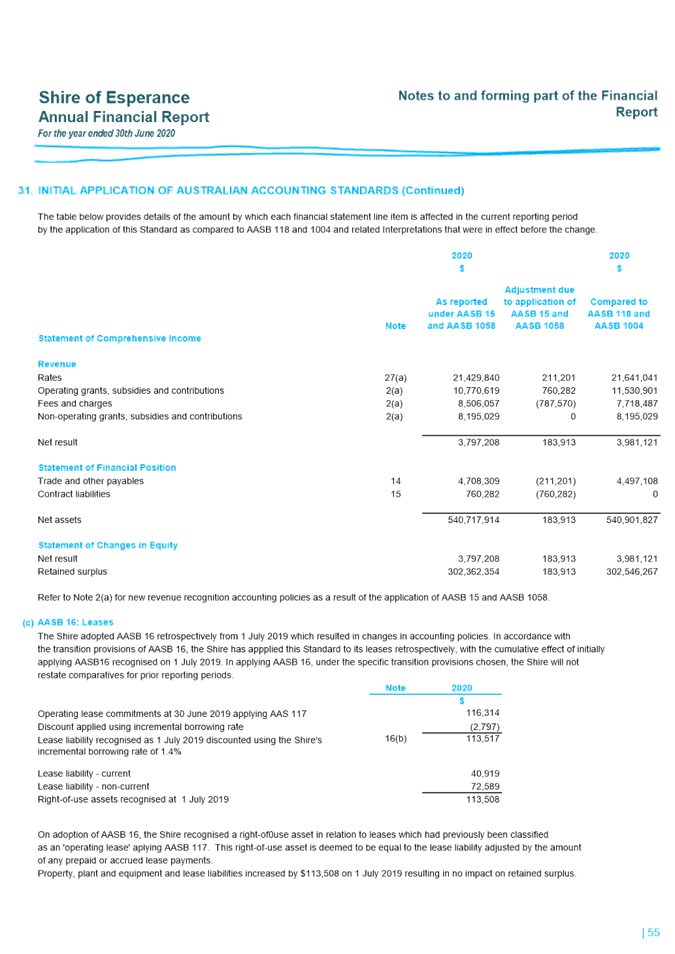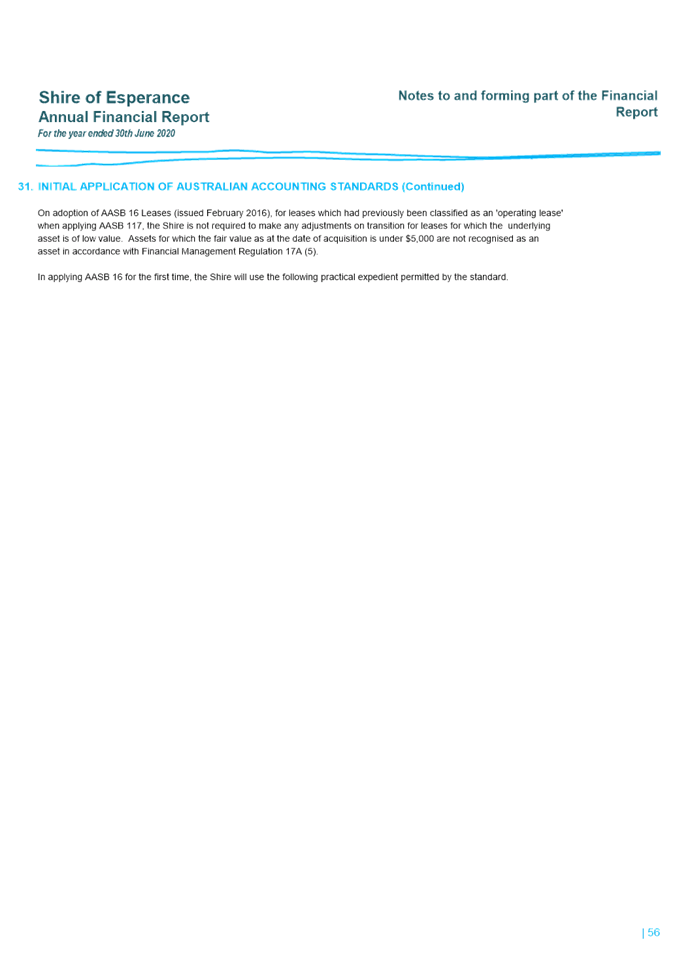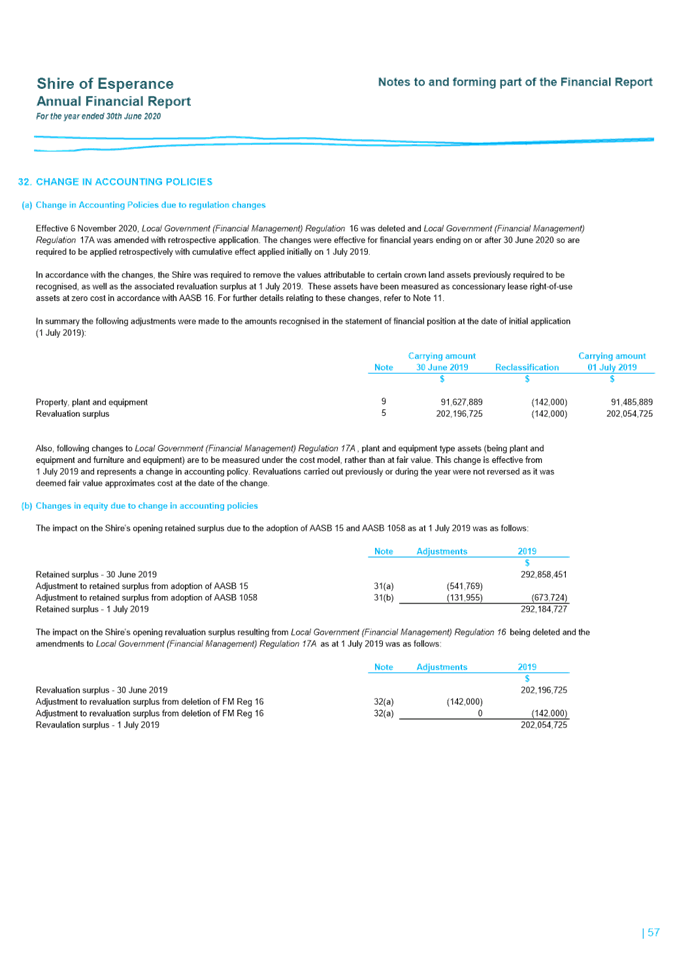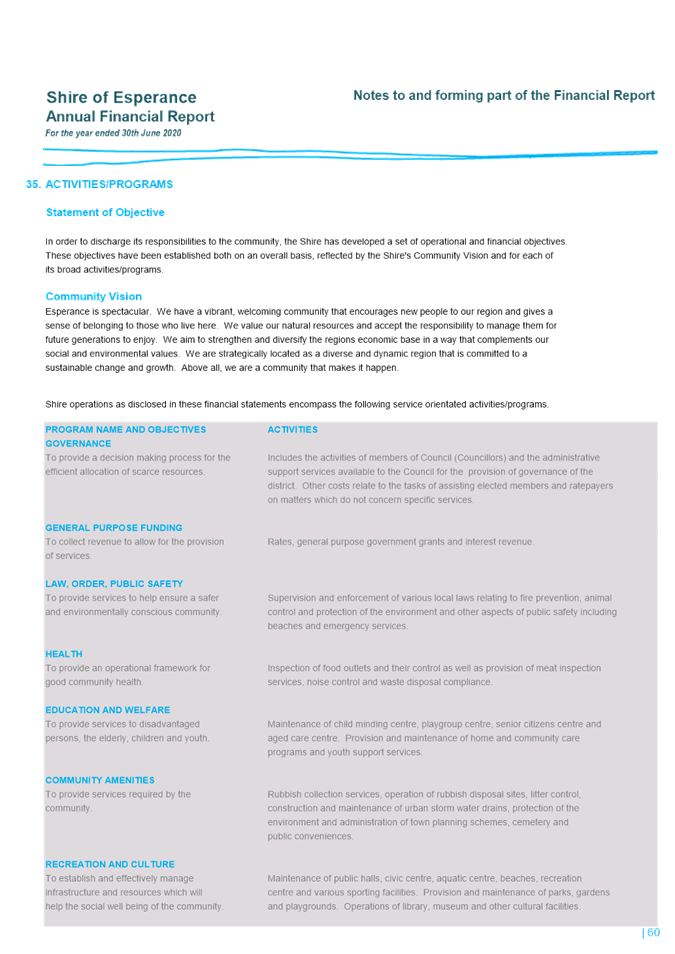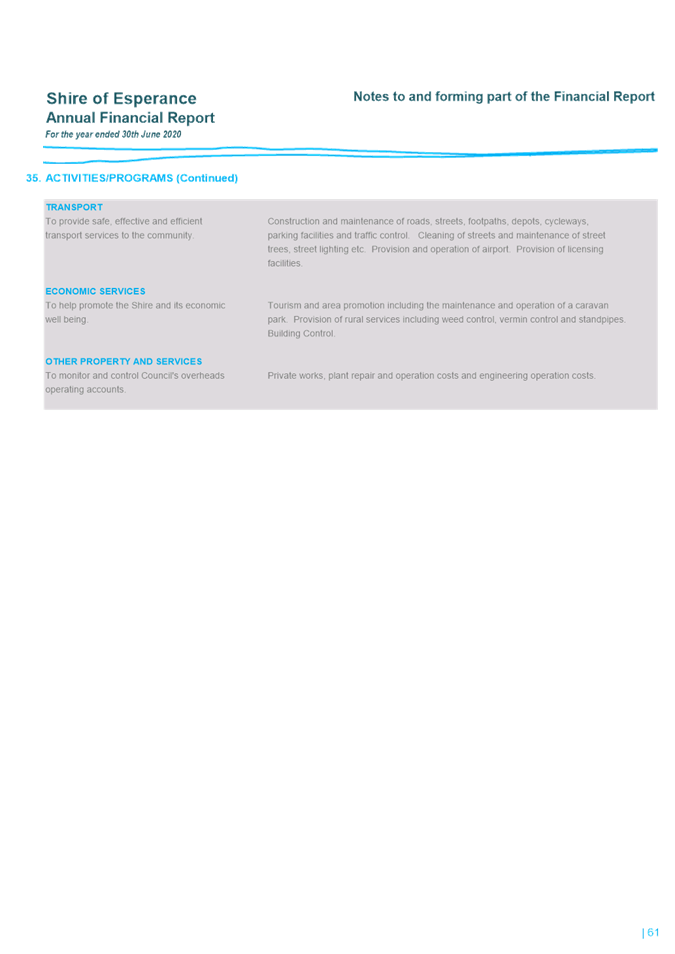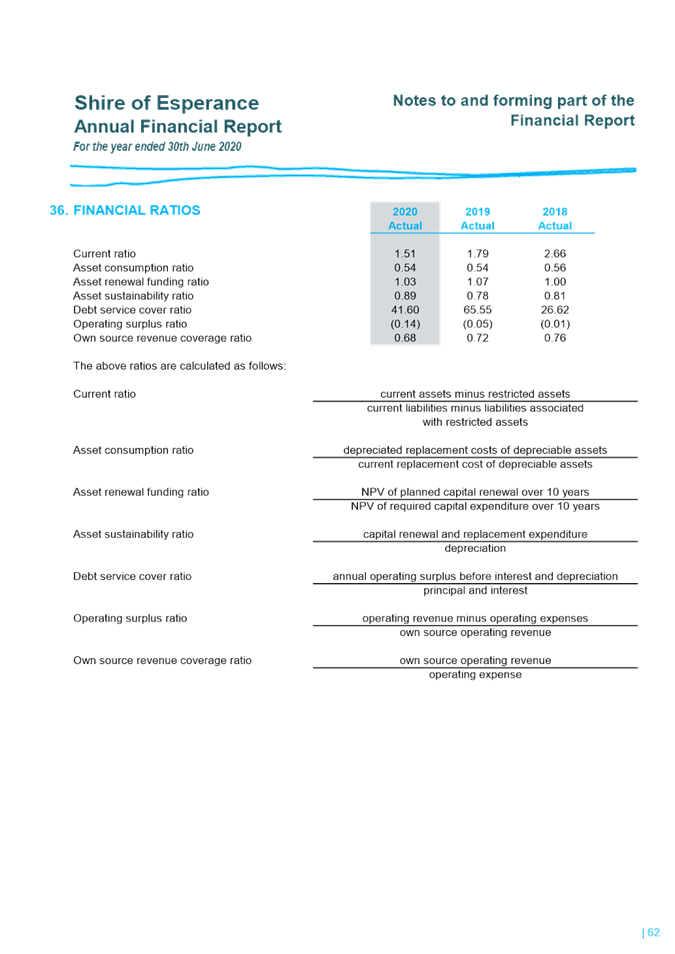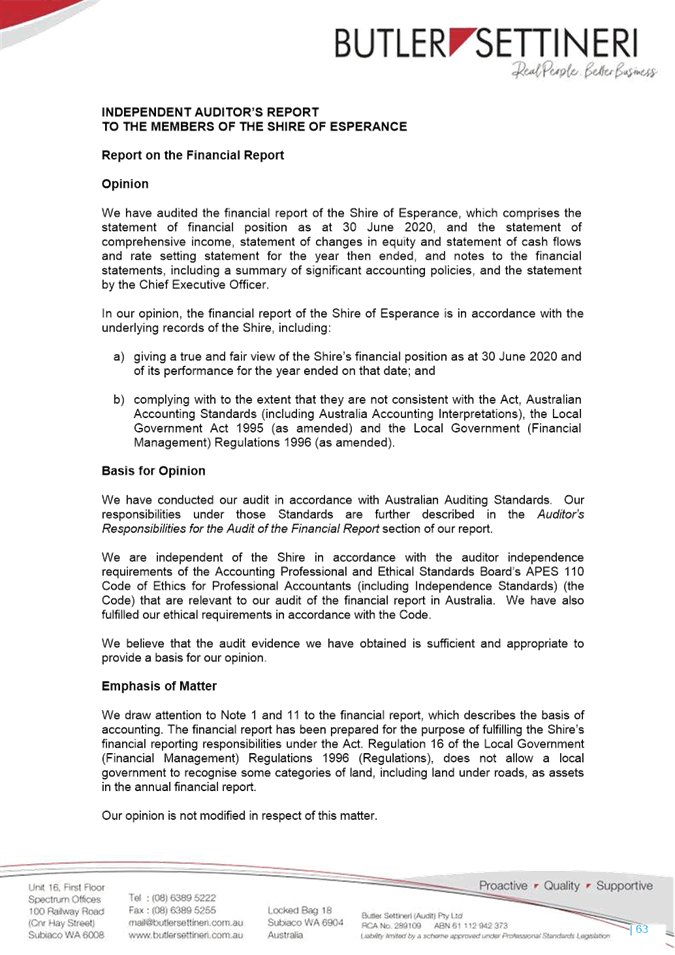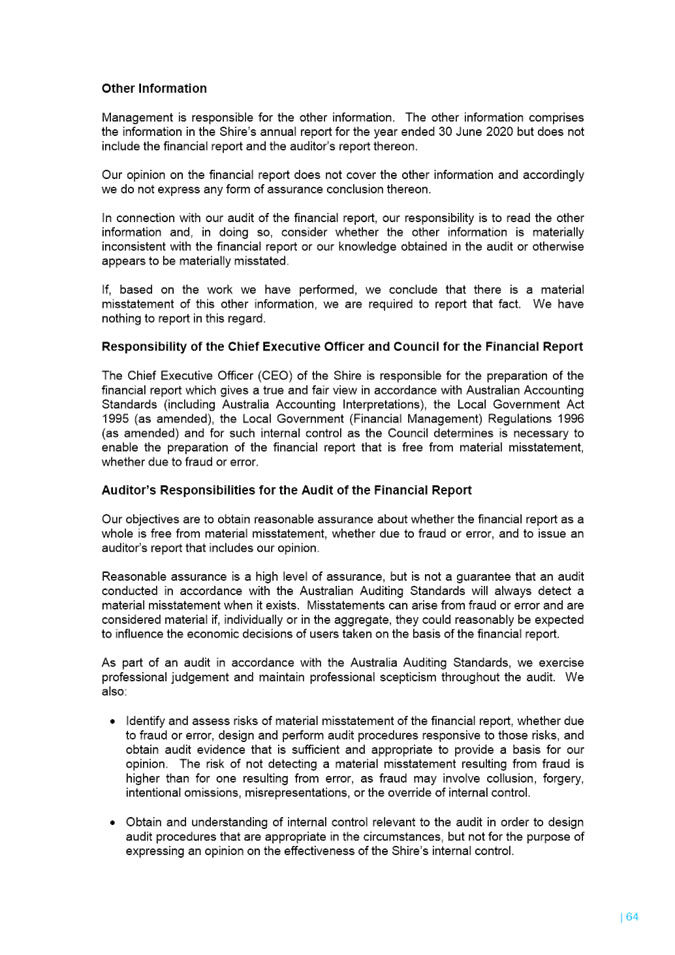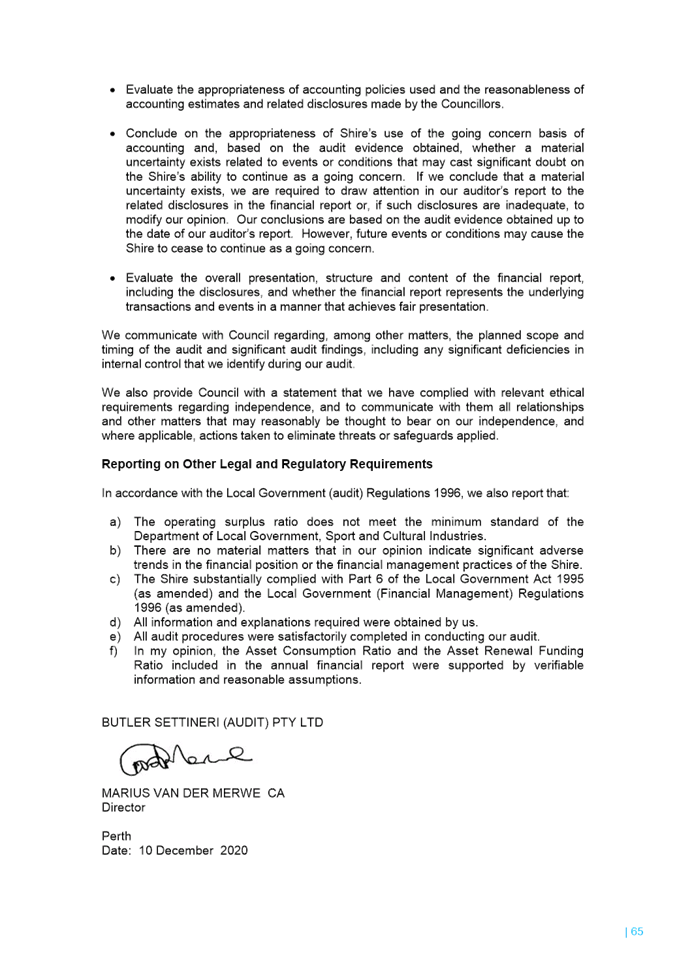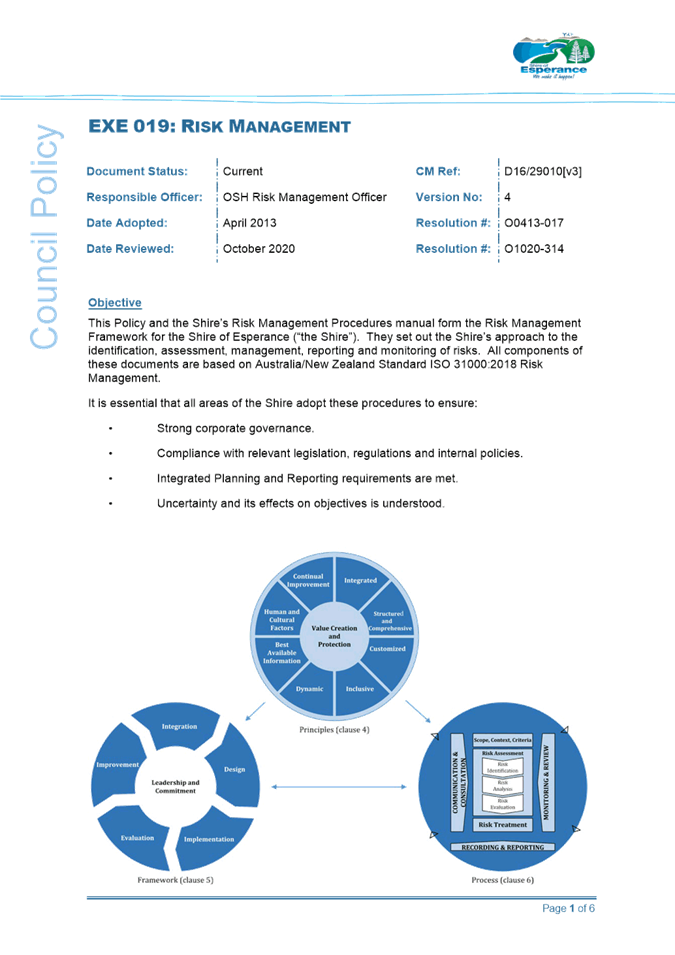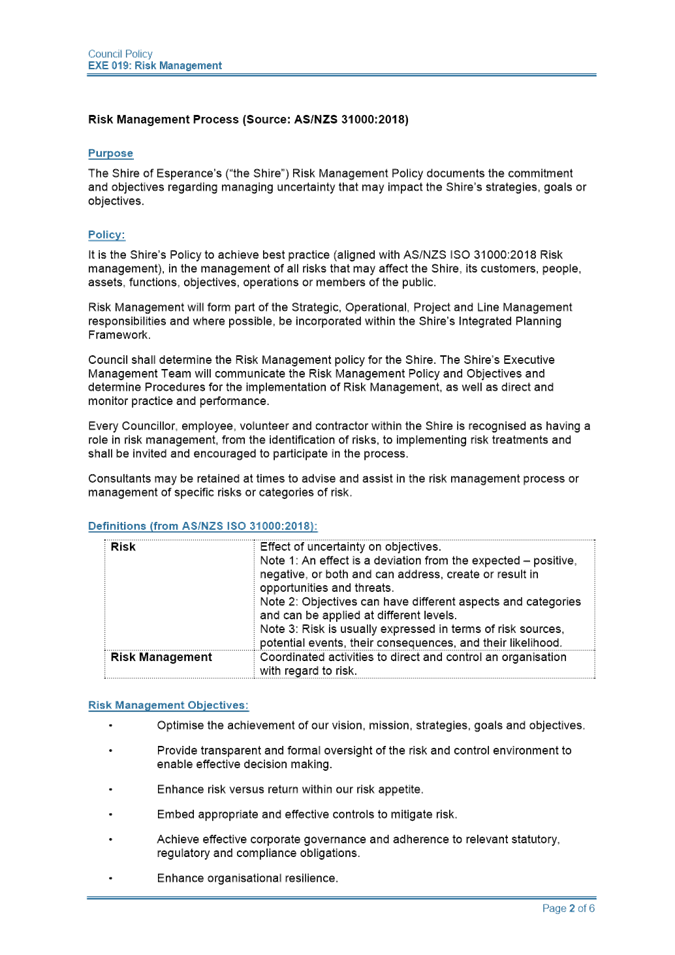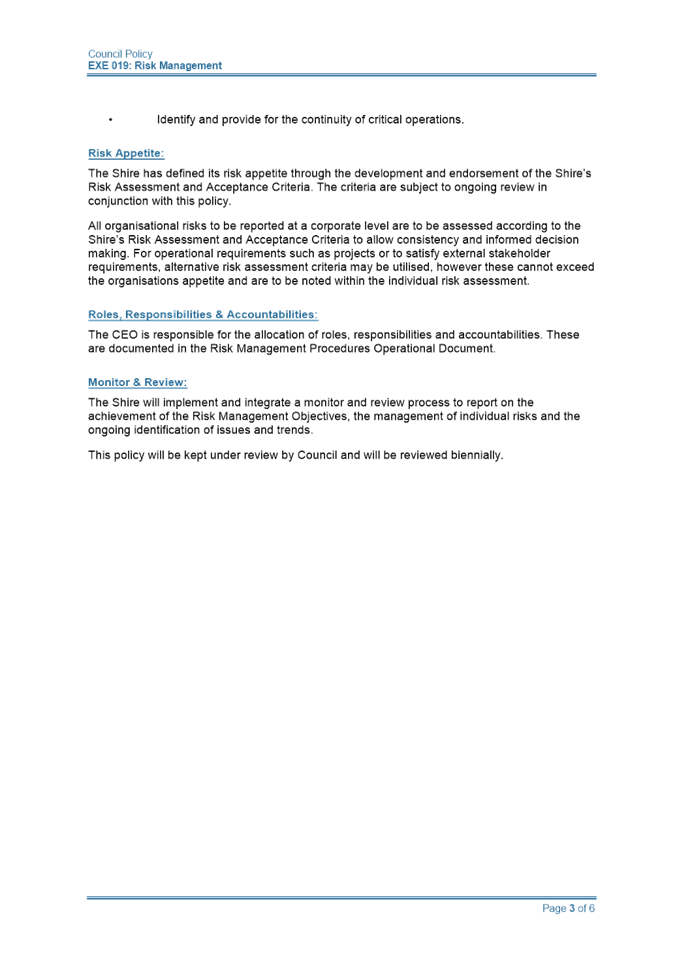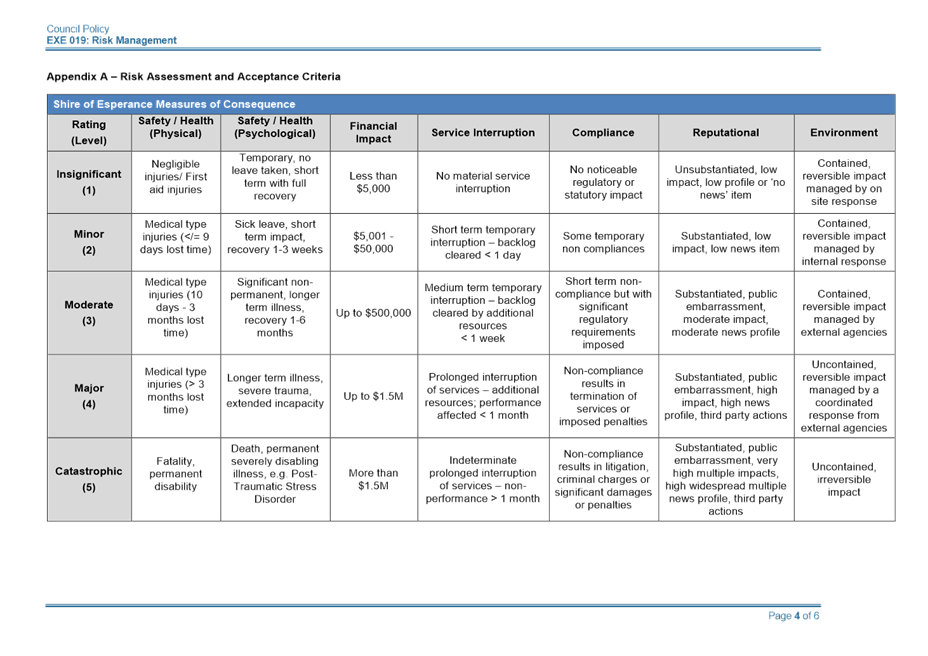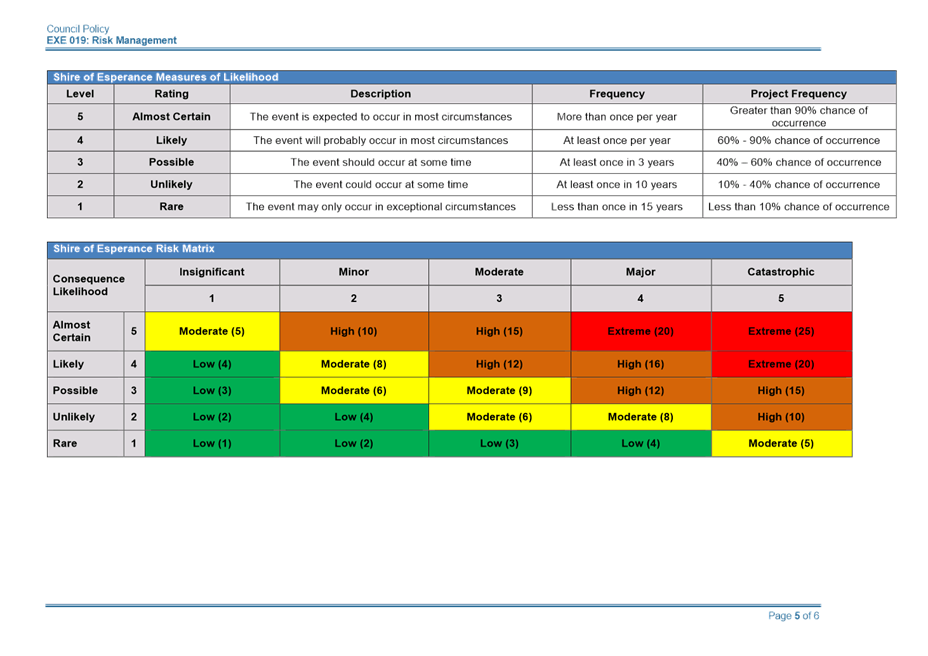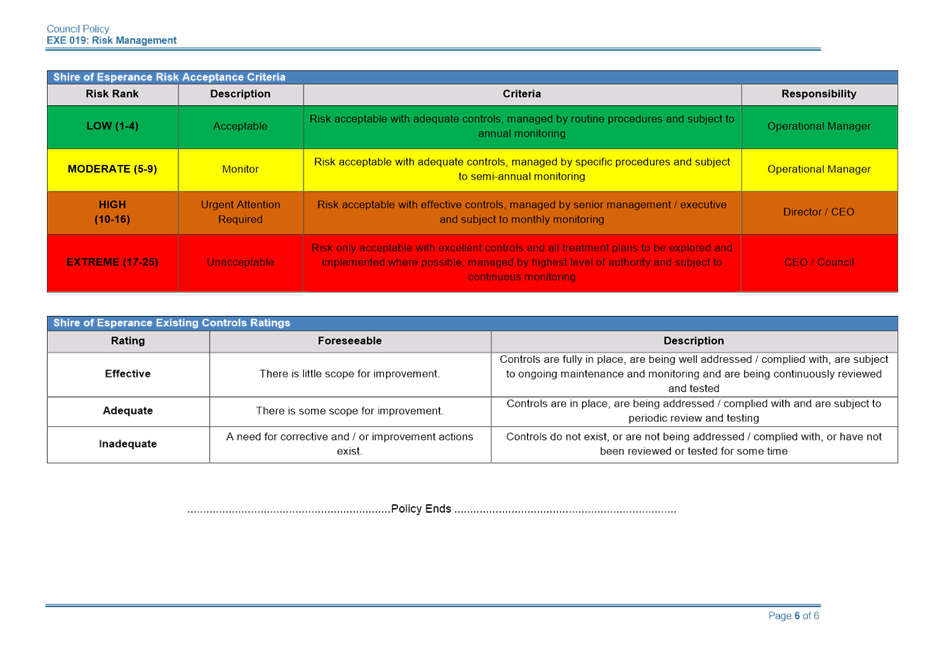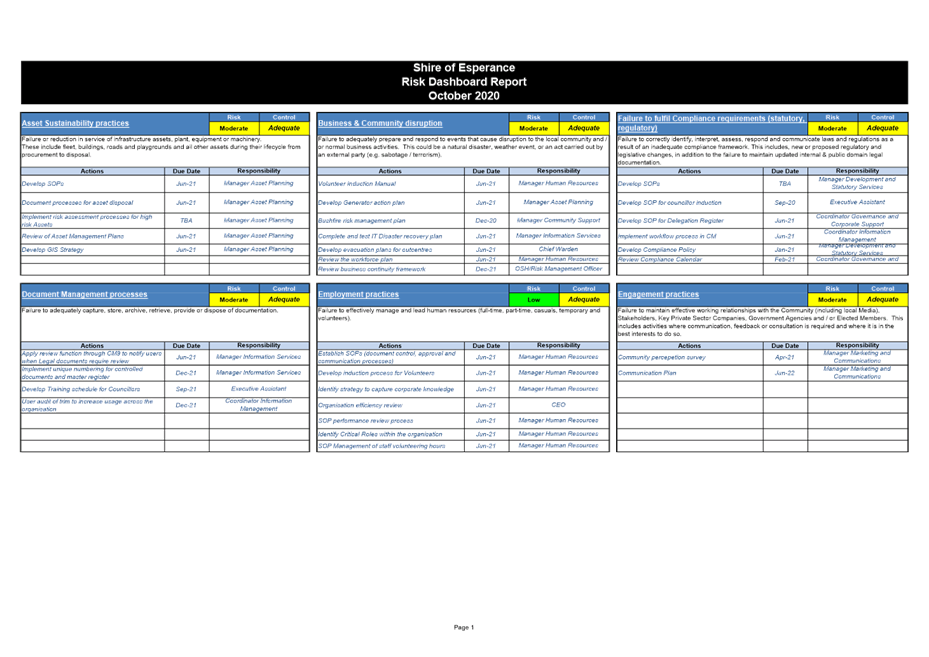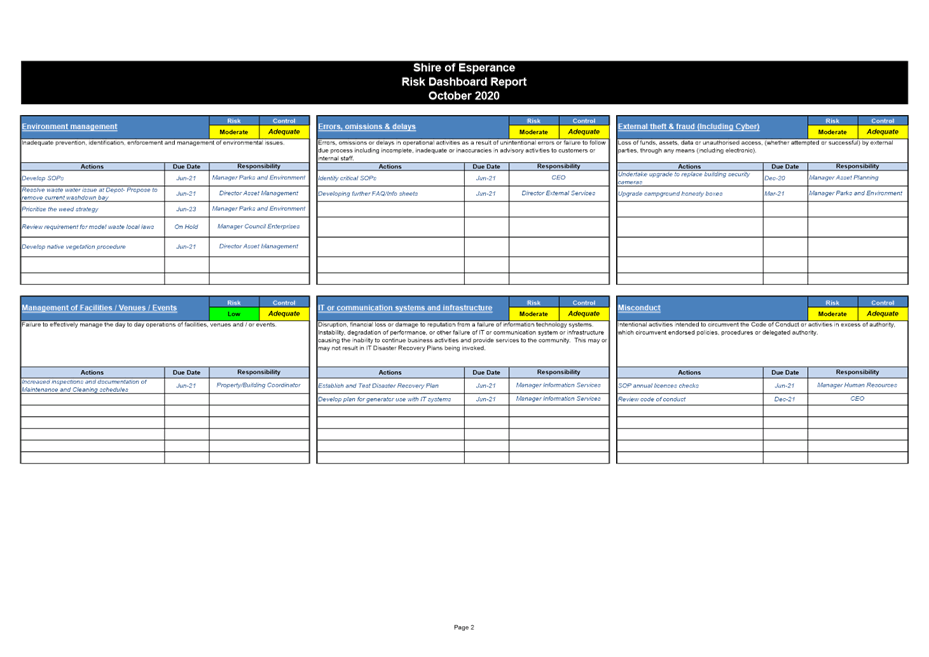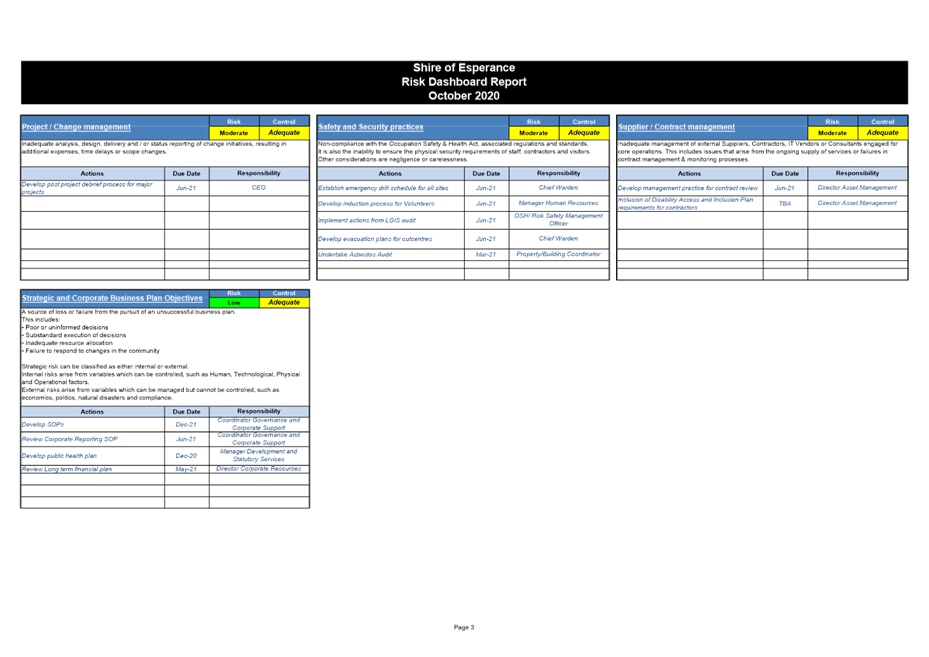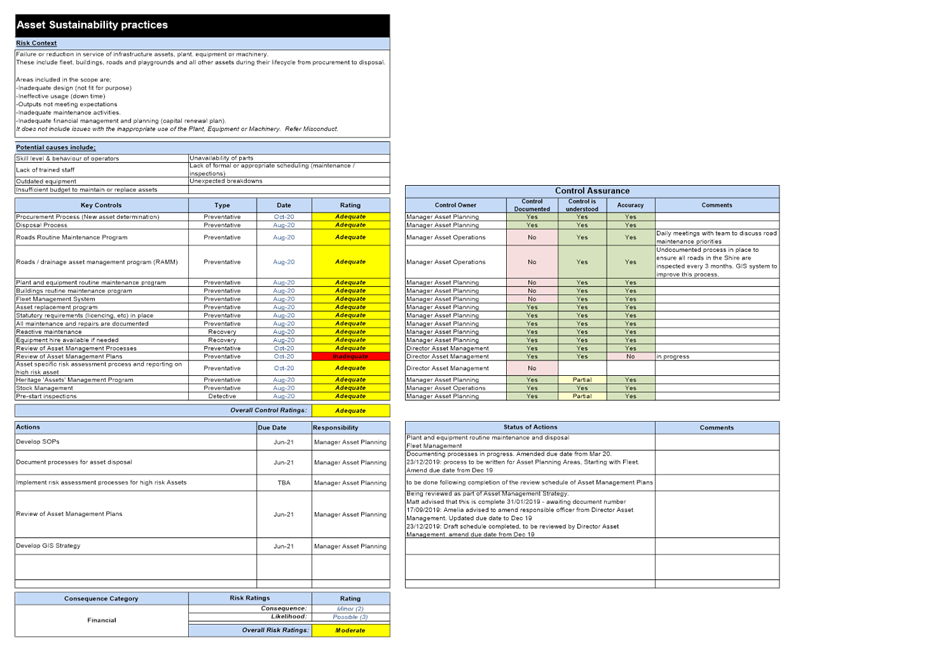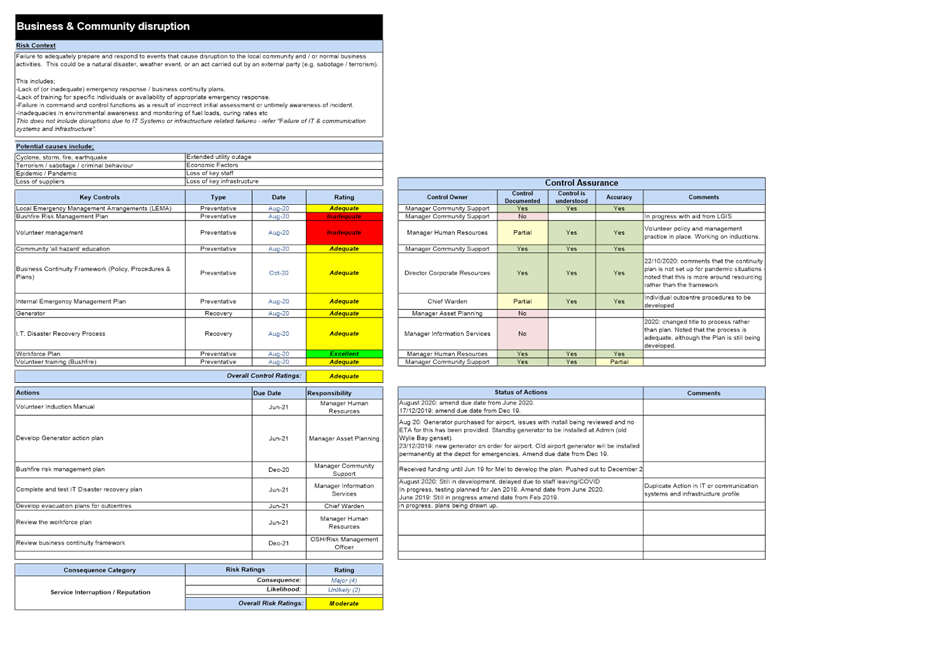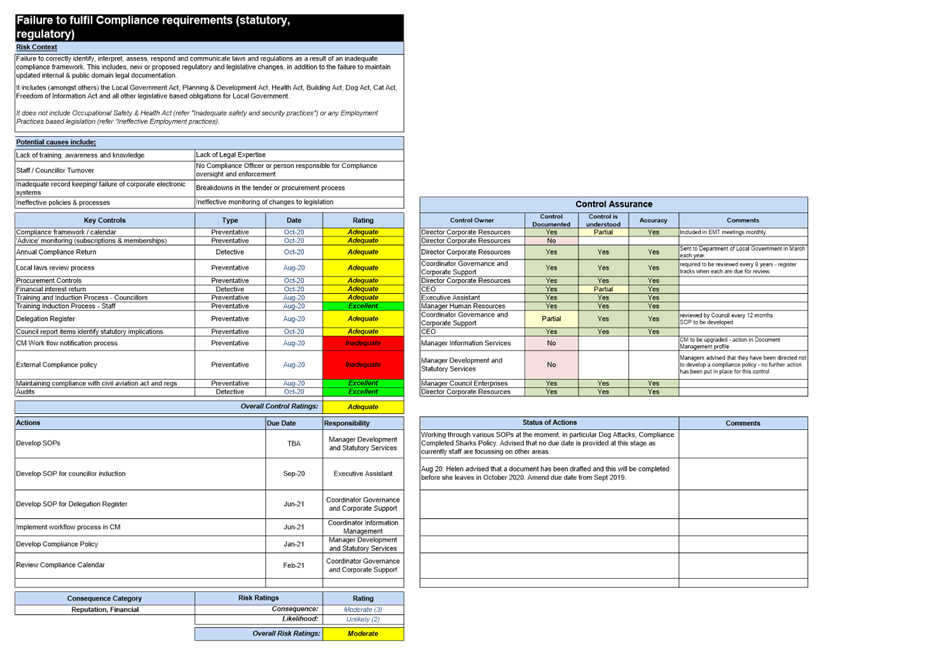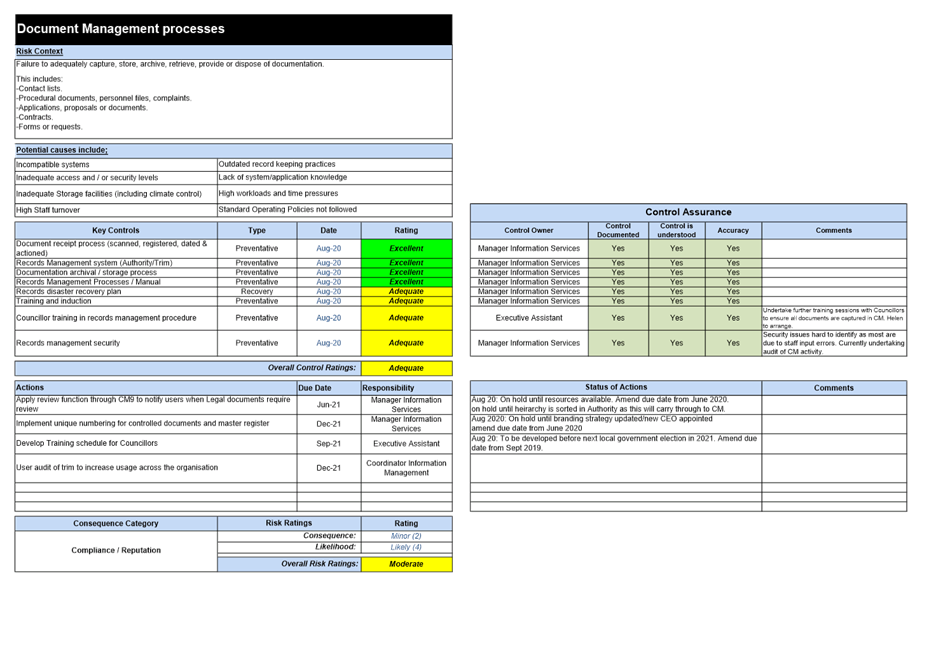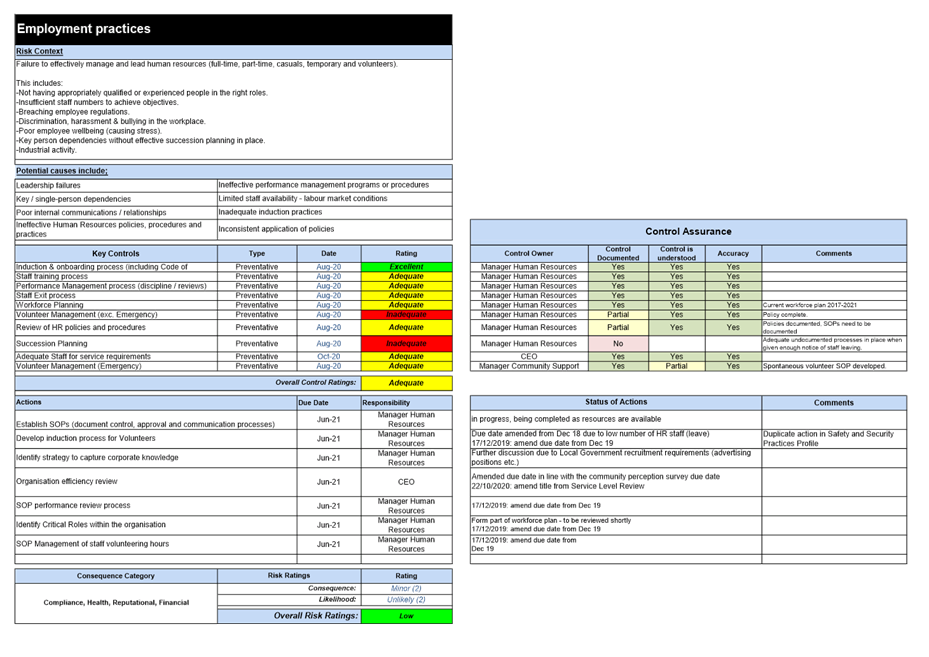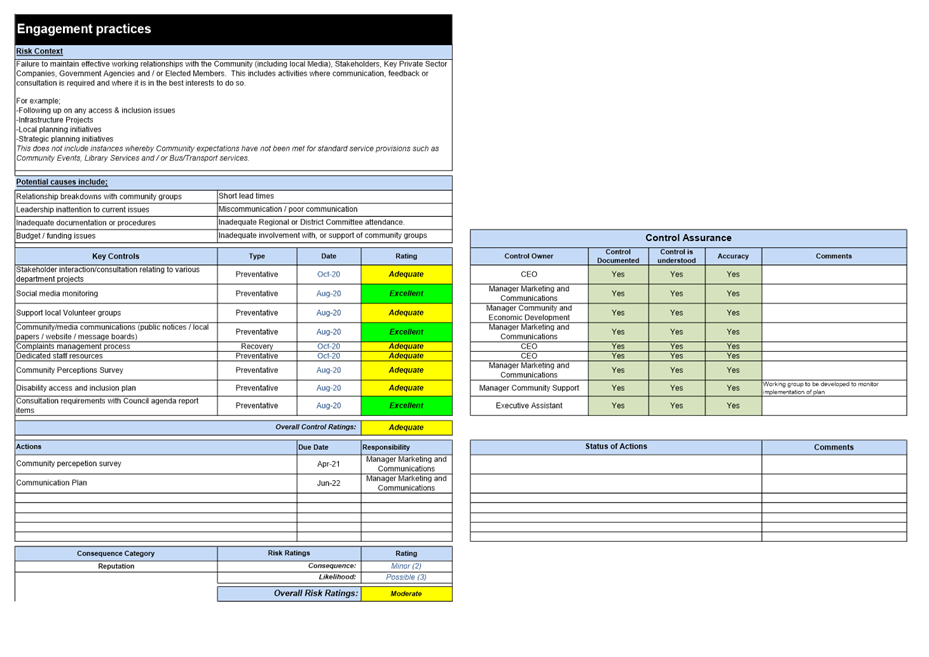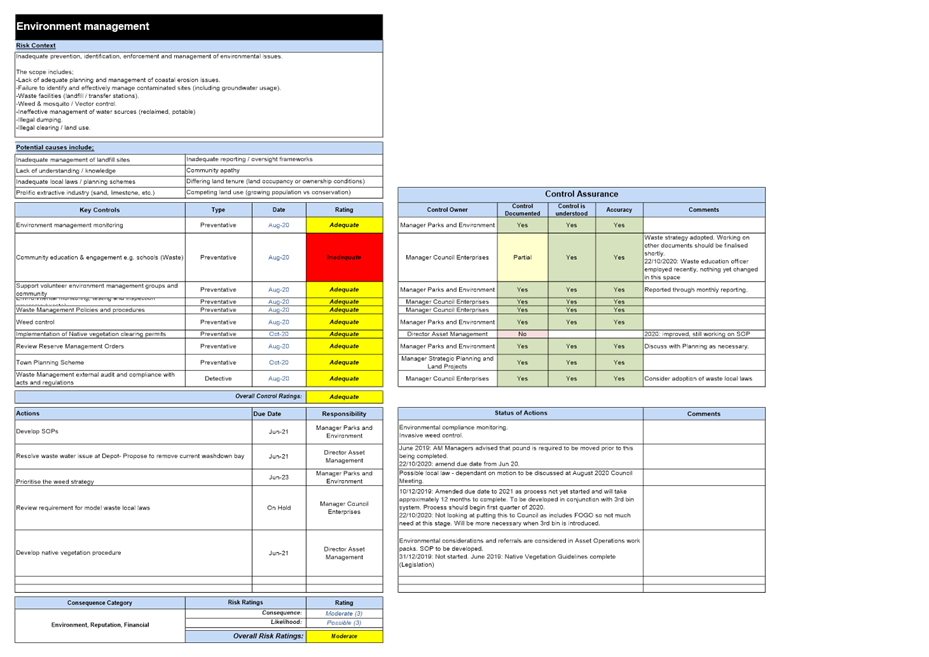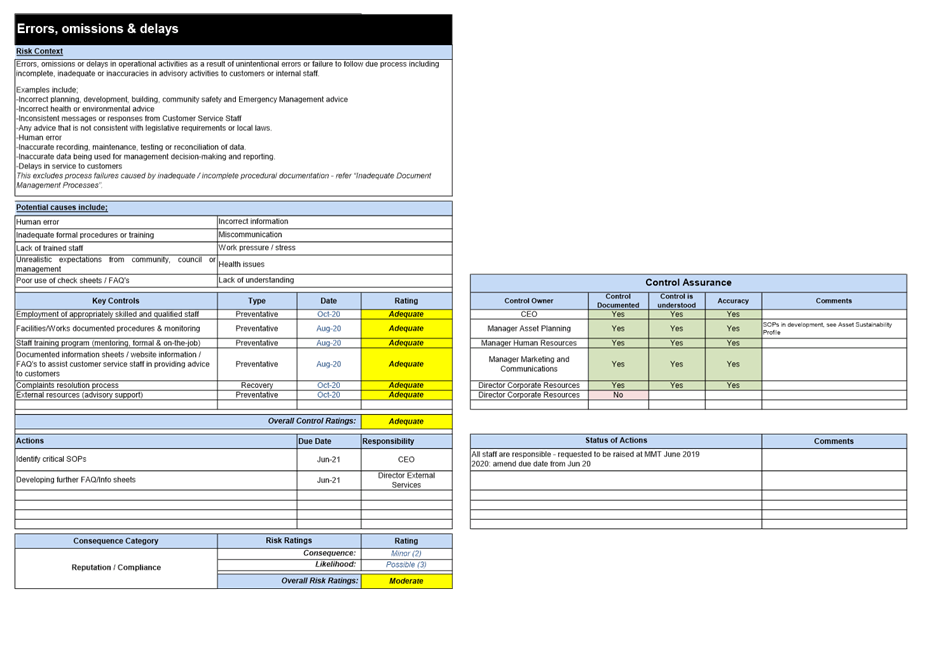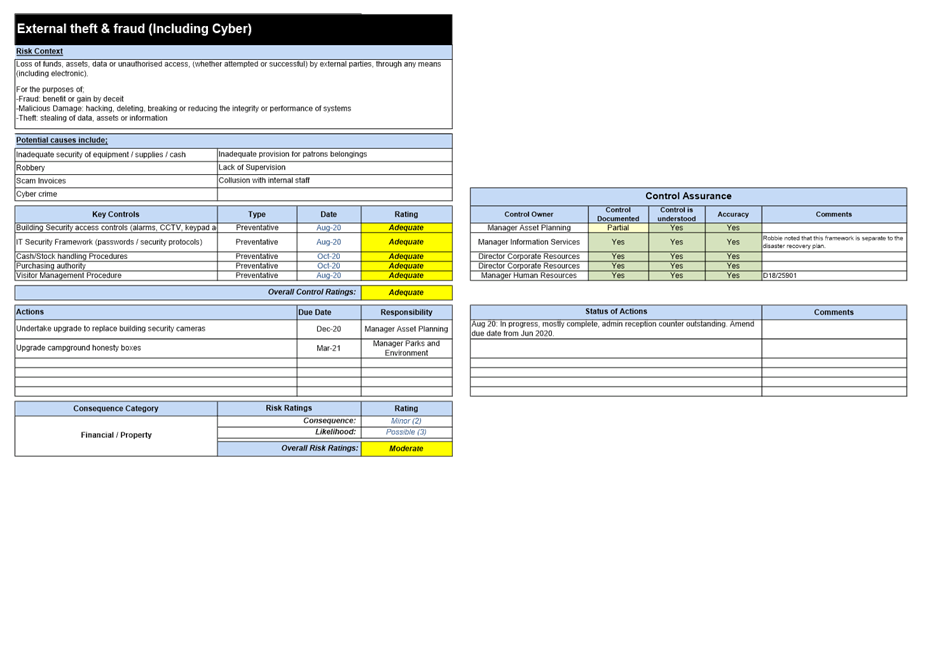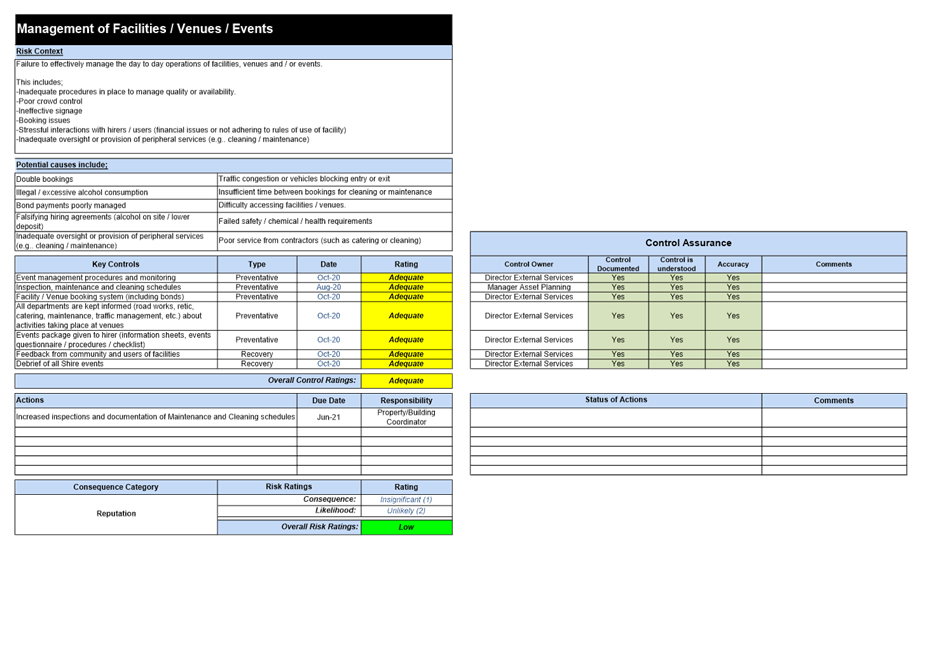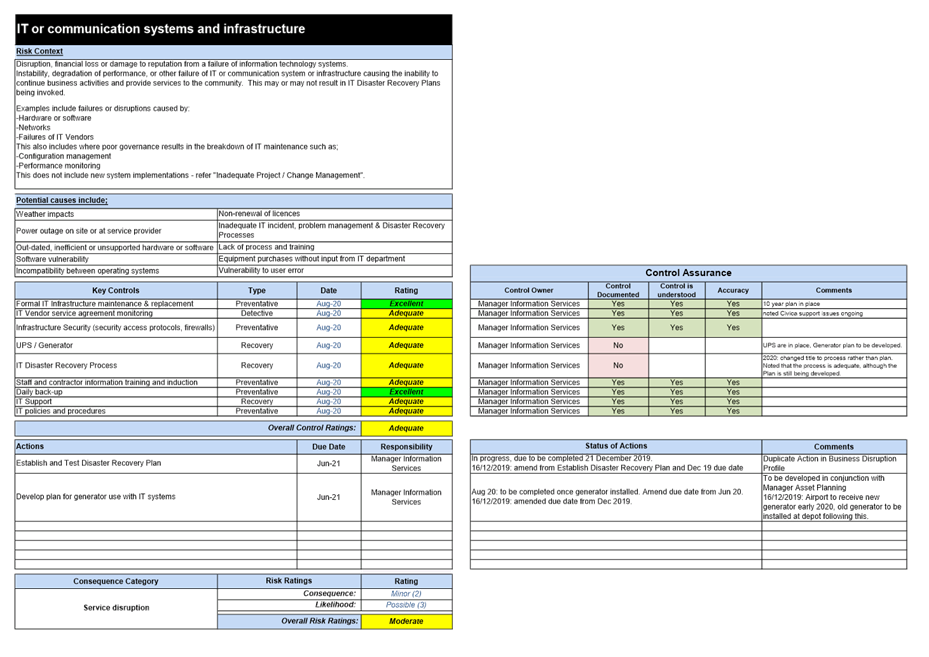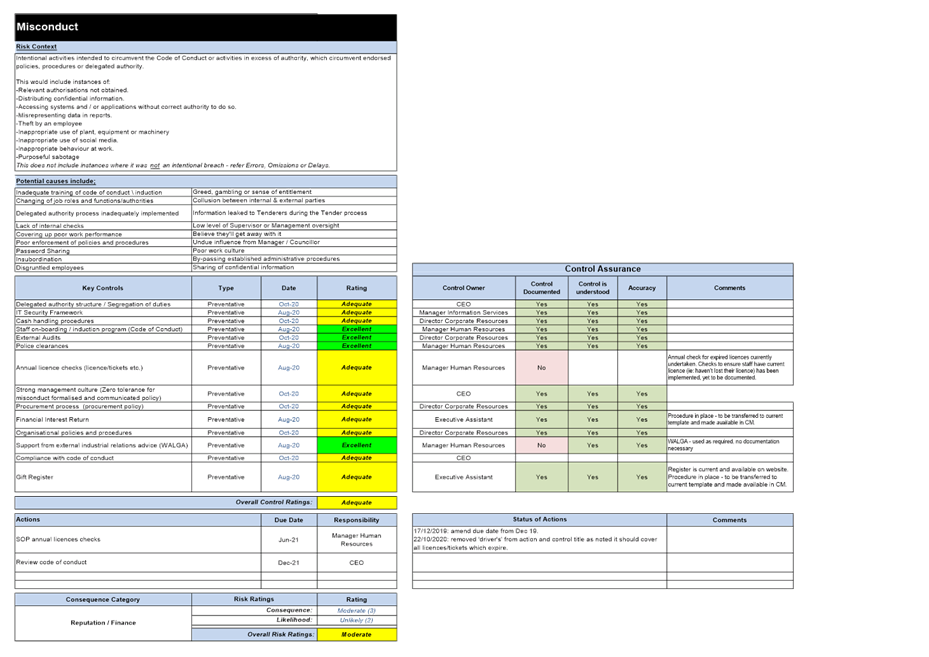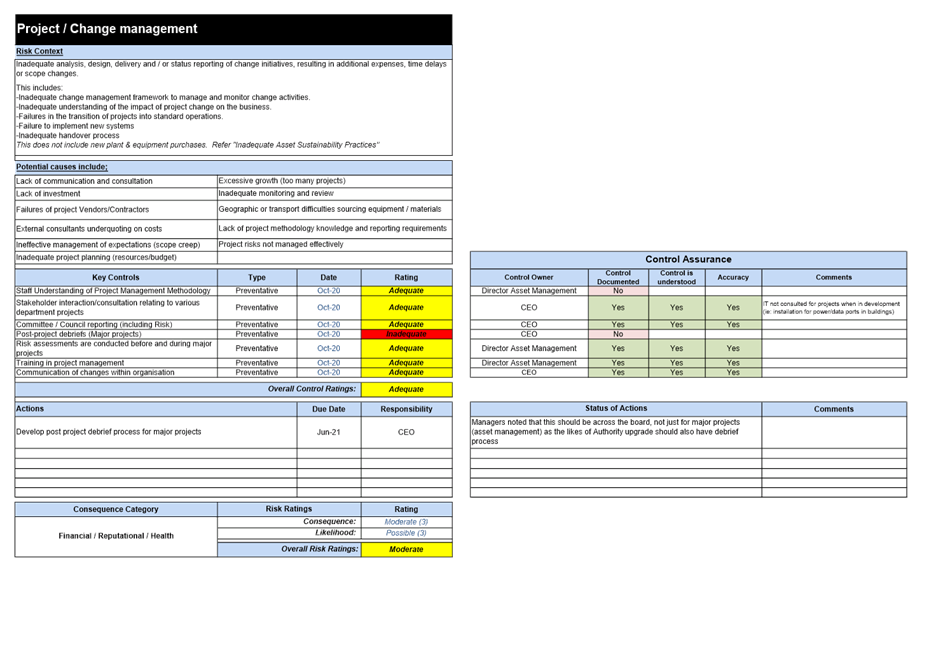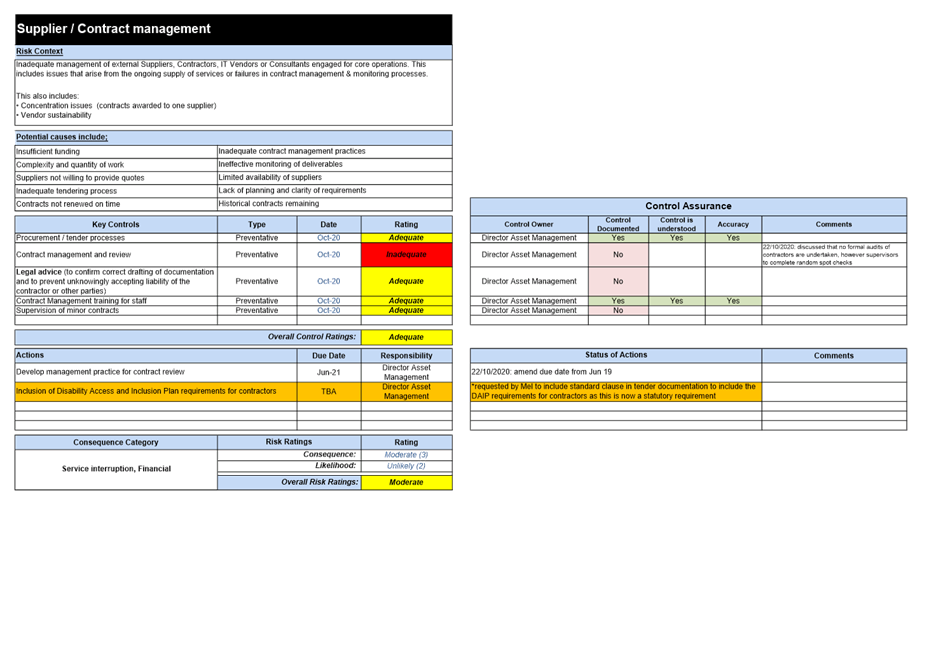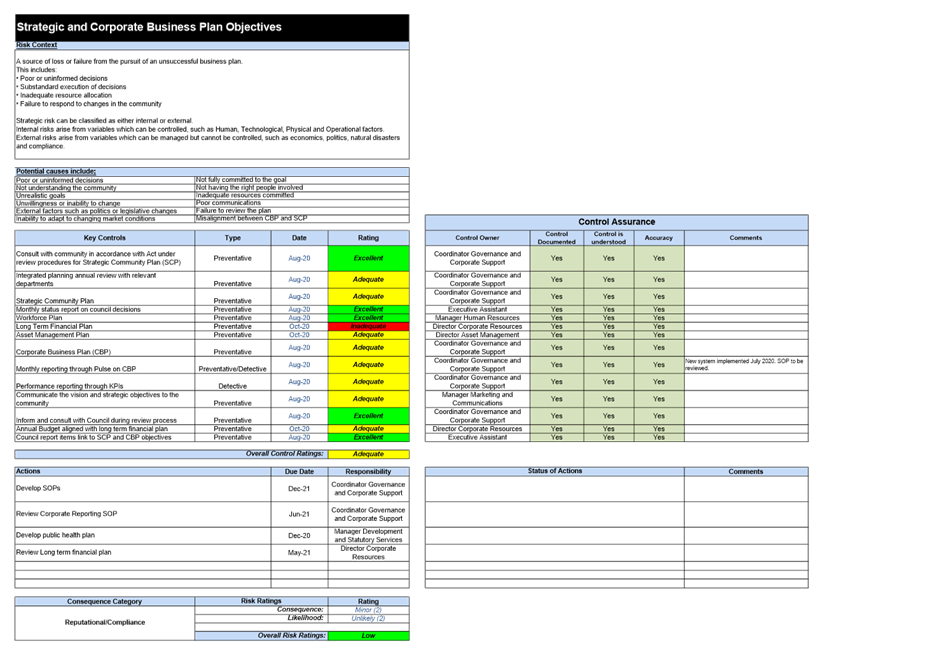9. Matters Requiring a Determination of
Committee
Item: 9.1
Airport
Safety Management System - Second Airport Vehicle
|
Author/s
|
Scott McKenzie
|
Acting Director External Services
|
|
Authorisor/s
|
Shane Burge
|
Chief Executive Officer
|
File Ref: D20/36042
Applicant
Internal
Location/Address
Not Applicable
Executive Summary
To allow Council to consider the risk of having one
vehicle available for the Airport Operations team.
Recommendation in Brief
That the Audit Committee recommend to Council that
Council endorse the short term loan of LV609 to the Airport Operations team and
consider a Capital Budget Bid for 2021/22 for a secondary airport vehicle.
Background
Prior to 2019, the Esperance Airport was staffed with
only one Shire officer physically located on site. Until that point, the
Airport Coordinator (to whom that officer reports) had been permanently based
within the Shire Administration Building in town given the necessary close
working relationship required between admin staff and airport operations.
Following the resignation of the former Airport Coordinator (Ali Cull) in 2019,
the decision was made to move the Airport Coordinator position permanently to
the Esperance Airport in order to improve operational oversight, provide
supervision and assistance to the sole Shire staff member on site and to foster
improved working relationships with Regional Express staff and other airport
tenants.
The additional Shire staff member being based on site
soon highlighted the risk of having only one available vehicle as the
relocation of the Airport Coordinator position meant that the only
‘airport ute’ was now increasingly away from site to attend the
Shire offices in town and purchase supplies etc. - issues that had previously
been served by access to the Shire admin vehicle fleet. This in turn created
the very real risk of the airport ute being absent from the airport during an
accident or incident. At airports, identified risks are assessed under a formal
Safety Management System (SMS), and per Attachment A, this particular risk was
assessed early in 2020, with the solution put in place recommending the
acquisition of a secondary vehicle as part of the next budgeting process.
Early in November 2020, a safety incident (refer
Attachment A) occurred where the airport ute was absent from the site leaving
the remaining on-site officer without a vehicle during a significant storm
event that saw flash flooding throughout Esperance, including the Esperance
Airport. To ensure aircraft safety, CASA require an aerodrome serviceability
inspection to be conducted as soon as practicable “…after a severe
wind event, a severe storm or a period of heavy rainfall”, and in this
particular case the process - which included closing gravel runway 03/21 due to
flooding - was impacted through the absence of the airport ute, increasing the
risk to aviation.
This incident and the associated risk (refer
Attachment A) was then considered at the next Directors Meeting, where it was
decided to immediately address the issue by reallocating an existing pool
vehicle to the airport as an interim measure until a secondary permanent
airport vehicle could be procured under a budget allocation in 2021/22.
Officer’s Comment
Under the Shire’s Occupational Safety and Health
Policy, CASA’s Manual of Standards (MOS Part 139) and indeed the
Esperance Airport Safety Management System (SMS), the Shire of Esperance has an
implicit responsibility to ensure that staff are adequately resourced to
perform their roles in the safest manner possible. In this case, the provision
of a secondary and interchangeable vehicle has been assessed as being the best
solution to ensure the ongoing safe operations of the Esperance Airport.
In addition to this, it is relevant to note that the Airport
Coordinator’s present additional workload as a ‘case manager’
or ‘development concierge’ in an effort to improve customer service
on a trial basis as part of the development approval process will take the
Airport Coordinator and vehicle away from the airport site more frequently.
Option
That the Audit Committee recommend to Council that Council
amend the 2020/21 Budget as below to allow for the purchase of a second Airport
vehicle;
|
Description
|
Budget Figure
|
Amended Figure
|
Variation
|
|
Purchase of Vehicles
|
7510-705-6665
|
$0
|
$42,250
|
$42,250
|
|
Transfer from Aerodrome Reserve
|
7510-955-910
|
($271,457)
|
($229,207)
|
($42,250)
|
|
Net result
|
$0
|
Consultation
Executive Management Team
Financial Implications
The risk of not having a second vehicle has been alleviated
in the short term by the Asset Management area delaying the sale of a 4WD ute
and providing this vehicle to the airport. The intention is to lodge a Capital
Bid for the 2021/22 Budget to allow the sale of LV609 and provide a secondary
vehicle to the airport.
Asset Management Implications
Nil
Statutory Implications
Nil
Policy Implications
Nil
Strategic Implications
Strategic Community Plan 2017 - 2027
Built Environment
Transport networks that
meet the needs of our community and provide safe movement for all users
Deliver a diverse,
efficient and safe transport system
Corporate Business Plan 2020/21 – 2023/24
B2.6 Manage the Esperance Airport
Environmental Considerations
Nil
Attachments
|
a⇩.
|
Risk Assessment - Lack of Second
Vehicle
|
|
|
Officer’s Recommendation
That the Audit Committee recommend
to Council that Council endorse the short term loan of LV609 to the Airport
Operations team and consider a Capital Budget Bid for 2021/22 for a secondary
airport vehicle.
Voting Requirement Simple Majority
|
Item: 9.2
Audit
Report 2019/20
|
Author/s
|
Beth O'Callaghan
|
Acting Director Corporate Resources
|
|
Authorisor/s
|
Shane Burge
|
Chief Executive Officer
|
File Ref: D20/36195
Applicant
Corporate Resources
Location/Address
Internal
Executive Summary
To present to the Audit Committee the 2019/20 Annual
Financial Report and Audit Report prepared by the Council’s auditor, Mr
Marius Van Der Merwe from Butler Settineri.
Recommendation in Brief
That the Audit Committee
1. Receive
the 2019/20 Annual Financial Report including the Audit Report as attached as
Attachment A.
2. Recommends
the Annual Financial Report and Audit Report for the 2019/20 financial year to
Council for adoption.
Background
Council is required to prepare a financial report and
present it to the Council’s auditor by 30 September each year. This
has been completed and the Annual Financial Report and Audit Report are
presented as Attachment A.
The Local Government Act (1995) requires that
the audit report and any management letter be examined by the local government
to determine if any matters raised in the report(s) require action to be
taken. After considering the audit report the local government is to
prepare a report on any actions to be taken in response to the audit report and
is to forward a copy of that report to the Minister for Local Government.
Officer’s Comment
The Council has received an unqualified or
“clean” audit report from Mr Van Der Merwe. The
auditor’s opinion state that:
“In our opinion, the financial report of
the Shire of Esperance is in accordance with the underlying records of the
Shire, including:
a)
giving a true and fair view of the Shire’s financial position as at 30
June 2020 and of its performance for the year ended on that date; and
b)
complying with to the extent that they are not consistent with the Act,
Australian Accounting Standards (including Australia Accounting
Interpretations), the Local Government Act 1995 (as amended) and the Local
Government (Financial Management) Regulations 1996 (as amended).”
It is now a legislative requirement for a separate report to
be presented to the Audit Committee and Council when significant matters are
raised in the Audit Report. See below section of the Act.
Section7.12A(4) of the Local
Government Act (1995) states:
A local government must-
(a) prepare a
report addressing any matters identified as significant by the auditor in the
audit report, and stating what action the local government has taken or intends
to take with respect to each of those matters; and
(b) give a copy of
the report to the Minister within 3 months after the audit report is received
by the local government
Within 14 days after a local
government gives a report to the Minister under subsection (4)(b), the CEO must
publish a copy of the report on the local government’s official website.
There were no significant matters raised in the Audit Report
and a management letter was not issued.
Therefore a report to the Minister will not be required.
Revaluation of land and buildings occurred during 2019/20
resulting in a net increase of $6.3m.
The four golf courses within the Shire of Esperance recorded
on the asset register as “land vested in and under the control of
Council” have been removed as per the change (deletion) of Financial
Management Regulation 16.
The 2019/20 surplus closing position has reduced to what was
presented to Council at Budget adoption by $211,201. This is the
prepayment of rates at 30 June which is now required (by new regulations) to be
recorded as a current liability until rates are striked for the new year.
This reduction in the carried forward opening position of the 2020/21 budget
will be addressed as part of the budget review proceedings due to commence in
January.
Consultation
Nil
Financial Implications
As per the 2020/21 Budget.
Asset Management Implications
Nil
Statutory Implications
The statutory implications associated with this item are Local Government Act
(1995) Section
7.12A which details duties with respect to audits.
Policy Implications
Nil
Strategic Implications
Strategic Community Plan 2017 - 2027
Leadership
A financially sustainable
and supportive organisation achieving operational excellence
Provide responsible
resource and planning management for now and the future.
Environmental Considerations
Nil
Attachments
|
a⇩.
|
Annual Financial Report 2019/20
|
|
|
Officer’s Recommendation
That the Audit Committee
1. receive
the 2019/20 Annual Financial Report including the Audit Report as attached
as Attachment A.
2. recommends
the Annual Financial Report and Audit Report for the 2019/20 financial year
to Council for adoption.
Voting Requirement Simple Majority
|
|
|
Item: 9.3
CEO
Review of Systems and Procedures
|
Author/s
|
Sarah Walsh
|
Coordinator Governance & Corporate Support
|
|
Authorisor/s
|
Beth O'Callaghan
|
Acting Director Corporate Resources
|
File Ref: D20/36210
Applicant
Internal
Location/Address
Shire of Esperance
Executive Summary
For the Audit Committee to consider the report from
the CEO on the appropriateness and effectiveness of the Shire of Esperance
systems and procedures in relation to risk management, internal control and
legislative requirements.
Recommendation in Brief
That the Audit Committee accept the report from the
CEO on the appropriateness and effectiveness of the Shire of Esperance systems
and procedures in relation to risk management, internal control and legislative
requirements and recommend the review to Council for endorsement.
Background
In accordance with Regulation 17 of the Local Government
(Audit) Regulations 1996, the CEO is required to review the appropriateness
and effectiveness of the Shire of Esperance’s systems and procedures in
relation to risk management, internal control and legislative requirements not
less than once every three years.
The review process was developed along with Local
Government Insurance Service (LGIS) during 2014 in regards to risk, internal
control and legislative compliance. The Department of Local Government has
developed guidelines to assist Local Governments in determining the issues that
should be considered in any review process -
Risk Management
Internal control and risk management systems and programs are
a key expression of a local government’s attitude to effective controls.
Good audit committee practices in monitoring internal control and risk
management programs typically include:
· Reviewing whether the local
government has an effective risk management system and that material operating
risks to the local government are appropriately considered;
· Reviewing whether the local
government has a current and effective business continuity plan (including
disaster recovery) which is tested from time to time;
· Assessing the internal processes for
determining and managing material operating risks in accordance with the local
government’s identified tolerance for risk, particularly in the following
areas;
– Potential
non-compliance with legislation, regulations, standards and local
government’s policies;
– Important accounting
judgements or estimates that prove to be wrong;
– Litigation and claims;
– Misconduct, fraud and theft;
– Significant
business risks, recognising responsibility for general or specific risk areas.
For example, environmental, occupational health and safety risk, and how they
are managed by the local government;
· Obtaining regular risk reports, which
identify key risks, the status and the effectiveness of the risk management
systems, to ensure that identified risks are monitored and new risks are
identified, mitigated and reported;
· Assessing the adequacy of local
government processes to manage insurable risks and ensure the adequacy of
insurance cover, and if applicable, the level of self-insurance;
· Reviewing the effectiveness of the
local government’s internal control system with management and the
internal and external auditors;
· Assessing whether management has
controls in place for unusual types of transactions and/or any potential
transactions that might carry more than an acceptable degree of risk;
· Assessing the local
government’s procurement framework with a focus on the probity and
transparency of policies and procedures/processes and whether these are being
applied;
· Should the need arise, meeting
periodically with key management, internal and external auditors, and
compliance staff, to understand and discuss any changes in the local
government’s control environment;
· Ascertaining whether fraud and
misconduct risks have been identified, analysed, evaluated and have an
appropriate treatment plan which has been implemented, communicated, monitored
and there is regular reporting and ongoing management of fraud and misconduct
risks.
Internal Control
Internal control is a key component of a sound governance
framework, in addition to leadership, long-term planning, compliance, resource
allocation, accountability and transparency. Strategies to maintain sound
internal controls are based on risk analysis of the internal operations of a
local government.
An effective and transparent internal control environment is
built on the following key areas:
· integrity and ethics;
· policies and delegated authority;
· levels of responsibilities and
authorities;
· audit practices;
· information system access and
security;
· management operating style; and
· human resource management and
practices.
Internal control systems involve policies and procedures that
safeguard assets, ensure accurate and reliable financial reporting, promote
compliance with legislation and achieve effective and efficient operations and
may vary depending on the size and nature of the local government.
Aspects of an effective control framework will include:
· delegation of authority;
· documented policies and procedures;
· trained and qualified employees;
· system controls;
· effective policy and process review;
· regular internal audits;
· documentation of risk identification
and assessment; and
· regular liaison with auditor and
legal advisors.
The following are examples of controls that are typically
reviewed:
· separation of roles and functions,
processing and authorisation;
· control of approval of documents,
letters and financial records;
· comparison of internal data with
other or external sources of information;
· limit of direct physical access to
assets and records;
· control of computer applications and
information system standards;
· limit access to make changes in data
files and systems;
· regular maintenance and review of
financial control accounts and trial balances;
· comparison and analysis of financial
results with budgeted amounts;
· the arithmetical accuracy and content
of records;
· report, review and approval of
financial payments and reconciliations; and
· comparison of the result of physical
cash and inventory counts with accounting records.
Legislative Compliance
The compliance programs of a local government are a strong
indication of attitude towards meeting legislative requirements. Audit
committee practices in regard to monitoring compliance programs typically
include:
· Monitoring compliance with
legislation and regulations;
· Reviewing the annual Compliance Audit
Return and reporting to Council the results of that review;
· Staying informed about how management
is monitoring the effectiveness of its compliance and making recommendations
for change as necessary;
· Reviewing whether the local
government has procedures for it to receive, retain and treat complaints,
including confidential and anonymous employee complaints;
· Obtaining assurance that adverse
trends are identified and review management’s plans to deal with these;
· Reviewing management disclosures in
financial reports of the effect of significant compliance issues;
· Reviewing whether the internal and/or
external auditors have regard to compliance and ethics risks in the development
of their audit plan and in the conduct of audit projects, and report compliance
and ethics issues to the audit committee;
· Considering the internal
auditor’s role in assessing compliance and ethics risks in their plan;
· Monitoring the local
government’s compliance frameworks dealing with relevant external
legislation and regulatory requirements; and
· Complying with legislative and
regulatory requirements imposed on audit committee members, including not
misusing their position to gain an advantage for themselves or another or to
cause detriment to the local government and disclosing conflicts of interest.
The last review was undertaken in November 2018 and the
review recently undertaken by the CEO is now to be considered.
The Shire’s Risk Management Policy (Attachment A)
provides guidance and direction in relation to risk management and determines
the Shire’s risk appetite with regard to the measures of consequence and
likelihood of each risk.
Officer’s Comment
Attachment B has the risk management report and the process
that the Shire has worked through to determine the level of risk for each risk
theme and to what level the risk is being managed. The executive summary
provides a brief snapshot of each risk profile with appropriate colour coding
to easily identify the risk rating along with the level of control. The
executive summary also outlines those actions that are proposed to improve the
level of control for the risk theme. The full analysis for each profile is then
attached listing all the controls and the effectiveness of each control.
Actions have been suggested to improve controls and therefore reduce the risk.
The treatment or action that is proposed will depend upon the
cost or resources required to improve the control. It may be determined that
some control measures are too resource intensive to implement compared to the
level of increased control that will be obtained. Prioritisation and analysis
of cost/benefit will be required in some instances due to resource or budget
constraints.
The risk management analysis has been a useful exercise to
evaluate the Shire’s business practices and determine how effectively
they are operating. The process is used to communicate to staff who have
responsibility for the areas around areas of improvement or efficiency. It is
expected that this high level risk analysis will also provide guidance in
future decision making and resource allocation where business practice needs
improvement or the Shire is exposed to an unacceptable level of risk.
Consultation
Middle Management
Directors
Financial Implications
Although there are no direct financial implications arising
from this report the actions that have been identified to increase controls or
reduce risk may have financial or resource implications for the organisation.
The cost of implementing the controls to reduce or manage risk will need to be
weighed up against the risk appetite of the organisation to determine the most
appropriate course of action.
Asset Management Implications
Nil
Statutory Implications
Local Government (Audit) Regulations 1996 – r.17 CEO to review certain
systems and procedures
Policy Implications
EXE019: Risk Management
Strategic Implications
Strategic Community Plan 2017 - 2027
Community Leadership
A financially sustainable
and supportive organisation achieving operational excellence
Provide responsible
resource and planning management for now and the future
Corporate Business Plan 2020/2021 – 2023/2024
Manage Risk Management System
Environmental Considerations
Nil
Attachments
|
a⇩.
|
Risk Management Policy
|
|
|
b⇩.
|
Risk Management Report
|
|
|
Officer’s Recommendation
That the Audit Committee;
1.
Accept the CEO’s review of the appropriateness and
effectiveness of the Shire of Esperance systems and procedures in relation to
risk management, internal control and legislative compliance; and
2. Recommend the review to
Council for endorsement.
Voting Requirement Simple Majority
|







































